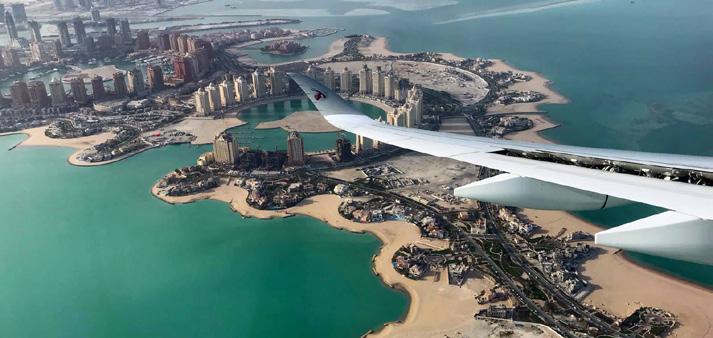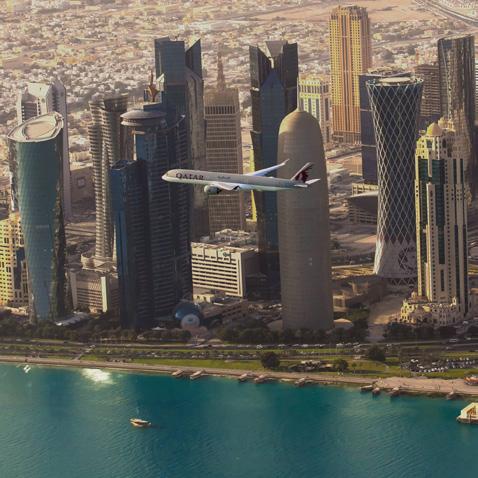
4 minute read
Qatar Airways- #Firstin1000
QATAR AIRWAYS - #FIRSTIN1000
On 23 February, Qatar Airways took delivery of its first A350-1000 from the Airbus HQ in Toulouse, France and created a launch event around it.
Advertisement

Qatar Airways is of course not the first airline to run marketing around new aircraft coming into its fleet.
For example, Thomson Airways in the UK heavily pre-promoted the fact that it was going to be the first British airline to fly the Dreamliner for months, and had ‘naming competitions’ where social media fans were able to name the new planes.
Meanwhile Qantas has created a slick and interactive dedicated Dreamliner landing page, and last year ran a campaign highlighting the fact that from this month, a 787-9 will be flying non-stop from Perth to London Heathrow (we covered the campaign and the ‘Feels like Home’ ads in the June 2017 edition).
However while a number of airlines have promoted the introduction of new aircraft into the fleet and even the first flight, fewer have taken a step back to look at how you can make more of out of the actual delivery flight, when the aircraft leaves the Airbus or Boeing HQ.
This was the thinking behind Qatar Airways #Firstin1000 mini-campaign. The campaign kicked off with an event in Toulouse which was broadcast on social media. In attendance were AV geeks - bloggers such as the London Spotter, the Points Guy, Sam Chui and The Airline and Aviation blog.
The aviation bloggers were invited to a dinner, there was a presentation and speeches and then the aircraft took off to Doha - with the bloggers on board.

Also on-board was Qatar Airways CEO Akbar Al Baker, who made himself available for video interviews with the bloggers. The A350-1000 did a fly-over over Doha, which was captured on Qatar Airways social media channels, before landing.
Inviting specialist airline and aviation bloggers and making them the focus of the flight from Toulouse was smart for a number of reasons.

First of all for AV geeks, a new aircraft being delivered and a visit to the Airbus factory is more than just a run of the mill trip. They were genuinely excited about this - it was probably the highlight of their year so far.
That meant they produced lots and lots of content. Videos, photos, and posts - and shared them extensively on their social media channels as well as writing articles on their actual blog.
NEW AIRCRAFT HELPS STRENGTHEN THE BRAND
Would the same have happened with a normal travel journalist? Travel writers are aware of the difference between different types of aircraft and they might well have been interested in looking around inside but the excitement levels were simply much different.
That’s because they have to appeal to and speak the language of their readers, most of whom won’t be frequent flyers who jet off somewhere every month. Many if not most readers of a travel section of a newspaper will fly once or twice a year.
And when they do book, the fact that airline A has new A350s and airline B still flies older A310s, doesn’t really come into it as a decision making factor.
IATA studies have shown that for the average consumer when it comes to actually buying a ticket the most important factor by far is price (43%), with the schedule (21%) ranking second and the frequent flyer programme (13%) far behind in third place.

However, while having a new kind of aircraft may not drive direct sales from ordinary consumers (as opposed to AV geeks), it does drive sales indirectly by helping to build an airline’s brand.
The same IATA research found that when it comes to an airline brand perception, the aircraft quality and interior was the second most important factor cited by 66% of respondents (On time performance was top with 75%).
KEY TAKE-AWAY
Work with AV geeks and spotters. It pays off.
They in some cases have a large audience that rivals conventional media outlets. To take one example, Sam Chui has 75k email newsletter subscribers, 136k Instagram followers and 35k Facebook fans. That’s in addition to the people who visit his blog.
That may not include that many leisure travellers who fly once a year, but it will include a lot of frequent flyers who spend a lot of money on airline travel.
They talk about aviation all the time, it is their life, that means they churn out much more content than your average travel blogger or journalist who would be on board. And that content lives on online. It will be found via Google or Bing search for months and years after it’s been posted and published.










